Description 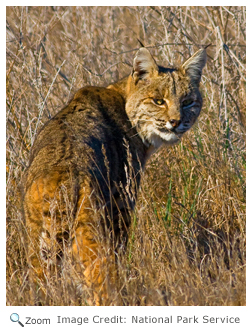 The bobcat is brown with black spots. Its fur may be grayer in winter. It has large ears with slight tufts of hair at the tips. It has a striped ruff of fur on its cheeks and a short tail with a black tip. It gets its name from its short or bobbed tail. The bobcat is about two feet tall from its shoulders to its feet. It weighs between 20 and 30 pounds. The bobcat has excellent eyesight and hearing. The bobcat is brown with black spots. Its fur may be grayer in winter. It has large ears with slight tufts of hair at the tips. It has a striped ruff of fur on its cheeks and a short tail with a black tip. It gets its name from its short or bobbed tail. The bobcat is about two feet tall from its shoulders to its feet. It weighs between 20 and 30 pounds. The bobcat has excellent eyesight and hearing.
Range
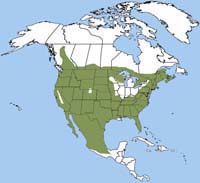 The bobcat is found in all of the United States, except for parts of the midwest. It is also found in Canada and Mexico. The bobcat is found in all of the United States, except for parts of the midwest. It is also found in Canada and Mexico.
In New Hampshire, the bobcat population probably numbers in the hundreds. It is the only large cat species still found in any significant numbers in the state. The mountain lion was found in New Hampshire until the late 1800s and the Canada lynx was present in the northern part of the state until the 1950s, although there have been some sightings of the lynx in the White Mountains.
Habitat
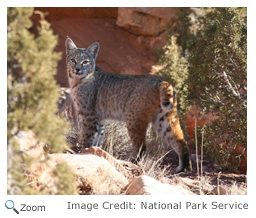 The bobcat lives in a wide variety of habitats including forests, deserts, mountains, swamps, and farmland. It lives in dens in a rock or tree crevice. The bobcat lives in a wide variety of habitats including forests, deserts, mountains, swamps, and farmland. It lives in dens in a rock or tree crevice.
| |
Diet  The bobcat is primarily nocturnal. It does most of its hunting at night. The bobcat is a carnivore and eats a wide variety of small mammals like woodchucks, rabbits, skunks, raccoons, moles, and squirrels. It also eats birds and reptiles. One of the most common prey of the bobcat is the cotton-tail rabbit. Occasionally, the bobcat kills larger prey, like deer. With small prey, the bobcat waits motionless and then pounces. The bobcat is primarily nocturnal. It does most of its hunting at night. The bobcat is a carnivore and eats a wide variety of small mammals like woodchucks, rabbits, skunks, raccoons, moles, and squirrels. It also eats birds and reptiles. One of the most common prey of the bobcat is the cotton-tail rabbit. Occasionally, the bobcat kills larger prey, like deer. With small prey, the bobcat waits motionless and then pounces.
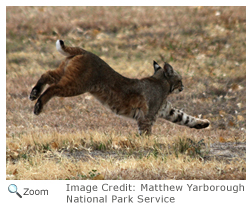 The bobcat stalks midsize prey and then pounces on it, grabbing its neck and cutting its spinal cord. If it hunts large prey like deer, it looks for them while they are bedded down. It eats small animals when it kills them. When it catches larger prey, it eats some and stores the rest to eat later. The bobcat stalks midsize prey and then pounces on it, grabbing its neck and cutting its spinal cord. If it hunts large prey like deer, it looks for them while they are bedded down. It eats small animals when it kills them. When it catches larger prey, it eats some and stores the rest to eat later.
Lifecycle 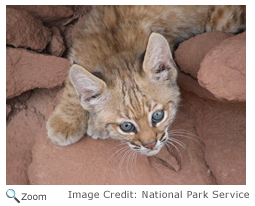 The bobcat mates between February and March. In late April or early May, the female gives birth to a litter of between one and seven kittens. The bobcat mates between February and March. In late April or early May, the female gives birth to a litter of between one and seven kittens.
Most litters have two to four kittens. The kittens are born with their eyes closed. After ten days their eyes will open. The kittens are weaned after about 10 weeks. The kittens stay with their mother for about a year.
Behavior
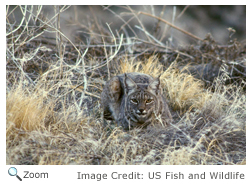 Bobcats are solitary animals. They mark their territory or home range with urine, feces, scent markings, scratches, and scrapes (piles of dirt and debris marked with scent.) A male's home range may overlap with the home range of a couple of females and often another male. The home range of females usually don't overlap. Home ranges can vary in size from less than a square mile to more than 20 miles, depending on the season of the year and the geographic location. Bobcats are solitary animals. They mark their territory or home range with urine, feces, scent markings, scratches, and scrapes (piles of dirt and debris marked with scent.) A male's home range may overlap with the home range of a couple of females and often another male. The home range of females usually don't overlap. Home ranges can vary in size from less than a square mile to more than 20 miles, depending on the season of the year and the geographic location.
 Bobcats are good swimmers and tree climbers, although they usually don't spend much time in trees. During the day, they prefer to rest on rocky ledges in a thicket. Bobcats are good swimmers and tree climbers, although they usually don't spend much time in trees. During the day, they prefer to rest on rocky ledges in a thicket.
|

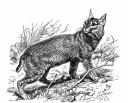

 The bobcat is found in all of the United States, except for parts of the midwest. It is also found in Canada and Mexico.
The bobcat is found in all of the United States, except for parts of the midwest. It is also found in Canada and Mexico.





